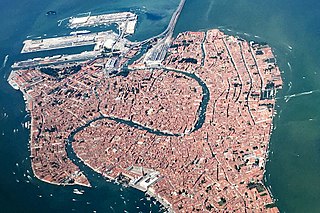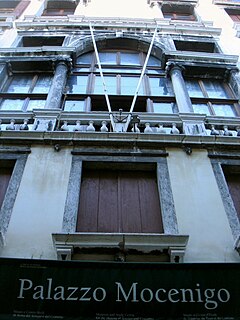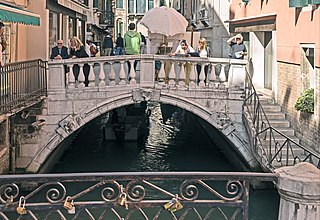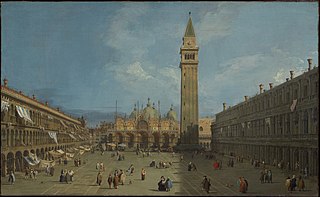
The Bridge of Sighs is a bridge in Venice, Italy. The enclosed bridge is made of white limestone, has windows with stone bars, passes over the Rio di Palazzo, and connects the New Prison to the interrogation rooms in the Doge's Palace. It was designed by Antonio Contino, whose uncle Antonio da Ponte designed the Rialto Bridge, and it was built in 1600.

Cannaregio is the northernmost of the six historic sestieri (districts) of Venice. It is the second largest sestiere by land area and the largest by population, with 13,169 people as of 2007.

Pietro II Orseolo was the Doge of Venice from 991 to 1009. He began the period of eastern expansion of Venice that lasted for the better part of 500 years. He secured his influence in the Dalmatian Romanized settlements from the Croats and Narentines, freed Venetia from a 50-year-old taxation to the latter, and started Venetia's expansions by conquering the islands of Lastovo (Lagosta) and Korčula (Curzola) and acquiring Dubrovnik (Ragusa).

The Grand Canal is a channel in Venice, Italy. It forms one of the major water-traffic corridors in the city.

The Brenta is an Italian river that runs from Trentino to the Adriatic Sea just south of the Venetian lagoon in the Veneto region, in the north-east of Italy.

The Rialto Bridge is the oldest of the four bridges spanning the Grand Canal in Venice, Italy. Connecting the sestieri (districts) of San Marco and San Polo, it has been rebuilt several times since its first construction as a pontoon bridge in the 12th century, and is now a significant tourist attraction in the city.

The Ponte dell'Accademia is one of only four bridges to span the Grand Canal in Venice, Italy. It crosses near the southern end of the canal, and is named for the Accademia di Belle Arti di Venezia, which from 1807 to 2004 was housed in the Scuola della Carità together with the Gallerie dell'Accademia, which is still there. The bridge links the sestieri of Dorsoduro and San Marco.

The Ponte degli Scalzi, is one of only four bridges in Venice, Italy, to span the Grand Canal.

Pietro I Orseolo, O.S.B. Cam. (928–987) was the Doge of Venice from 976 until 978. He abdicated his office and left in the middle of the night to become a monk. He later entered the Camaldolese Order. He is venerated as a saint in the Roman Catholic Church following his canonization in 1731. In 1733 the Venetian librarian, Giuseppe Bettinelli, published an edition of a biography written by the infamous heretical Friar Fulgenzio Manfredi in 1606.
Pietro Barbolano was the 28th Doge of Venice. Reportedly a descendant of the legendary Eraclea, he was elected by the assembly of the nobles after the deposition of his predecessor, Otto Orseolo. The dates of his birth and death are unknown.

Otto Orseolo was the Doge of Venice from 1008 to 1026. He was the third son of Pietro II Orseolo and Maria Candiano, whom he succeeded at the age of sixteen, becoming the youngest doge in Venetian history.

The Fondaco dei Tedeschi is a historic building in Venice, northern Italy, situated on the Grand Canal near the Rialto Bridge. It was the headquarters and restricted living quarters of the city's German (Tedeschi) merchants.

The Church of Santa Maria Assunta is a basilica church on the island of Torcello, Venice, northern Italy. It is a notable example of Venetian-Byzantine architecture, one of the most ancient religious edifices in the Veneto, and containing the earliest mosaics in the area of Venice.

Domenico Morosini was the thirty-seventh doge of the Republic of Venice, reigning from 1148 until his death in 1156.

Malamocco was the first, and for a long time, the only settlement on the Lido of Venice barrier island. It was the location of the original home of the Doge of Venice. Located just south of the island's center, it is part of the Lido-Pellestrina borough of the Comune of Venice. It is sometimes mis-identified as Metamaucum, though the latter town was located on a nearby island, and was submerged by rising sea levels.

Ca' Farsetti is a palace in Venice, Italy. It is located in the sestiere (district) of San Marco, and faces the Grand Canal, not far from the Ponte di Rialto.

The Museo di Palazzo Mocenigo is a palazzo near the Church of San Stae, south of the Grand Canal in the sestiere of Santa Croce in Venice, Italy. It is now a museum of fabrics and costumes, run by the Fondazione Musei Civici di Venezia.

Ponte dei Bareteri is a bridge in Venice, Italy. It is named after manufacturers of caps which were common in the area.

The Ponte del Paradiso is a bridge located in Venice, Italy. Crossing the Rio del Mondo Novo, the bridge is almost entirely constructed out of Istrian stone bricks while the steps are paved with Trachyte. It is located within Castello, the largest of the Venetian sestieres. The bridge is known for the unique arch on its southern side serving as an entrance to the Calle del Paradiso, an alley famous for its wooden overhanging eaves.

The Siege of Lastovo in 1000 was part of the campaign of Doge Pietro II Orseolo in southern Croatia and its bloodiest armed conflict between the citizens of Lastovo island and the army of the Venice. The siege resulted in a Venetian victory and Lastovo became part of the Venetian Republic for a while.






















